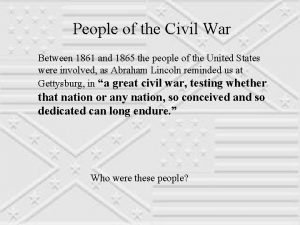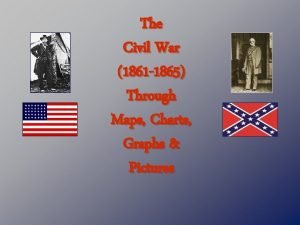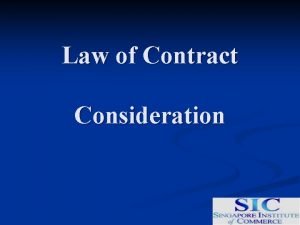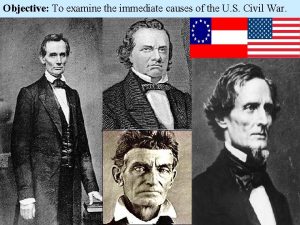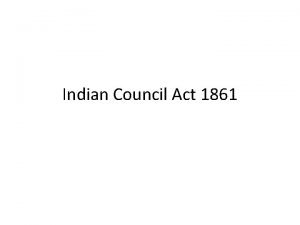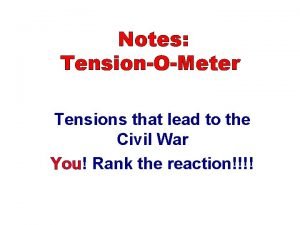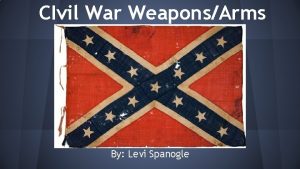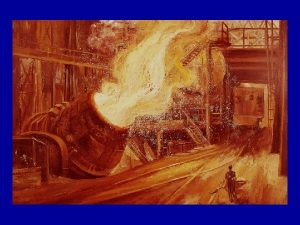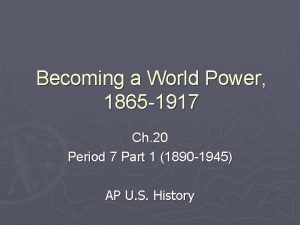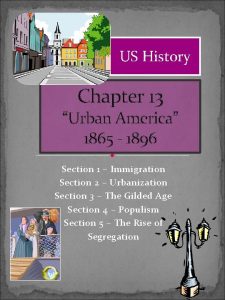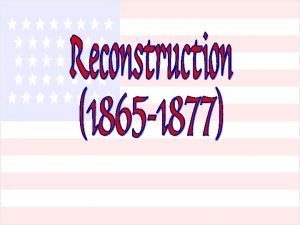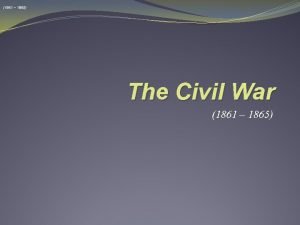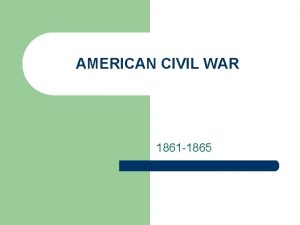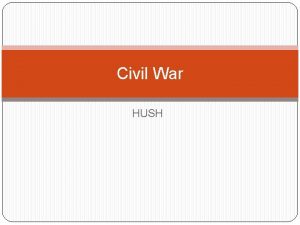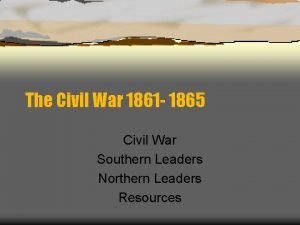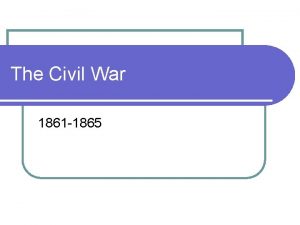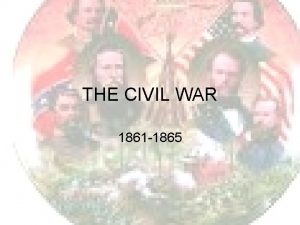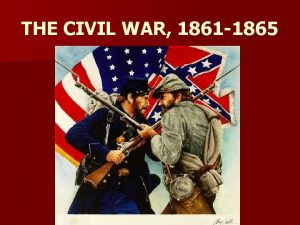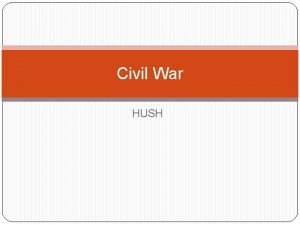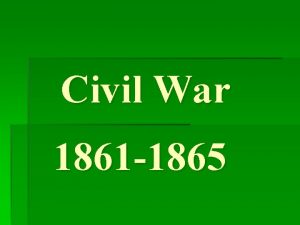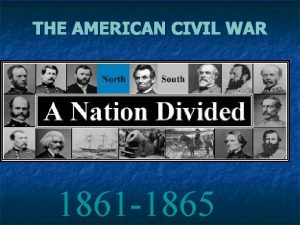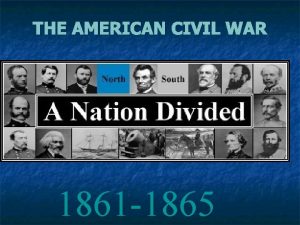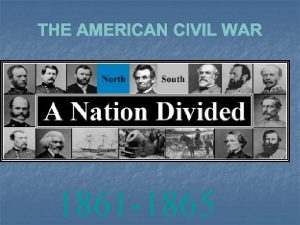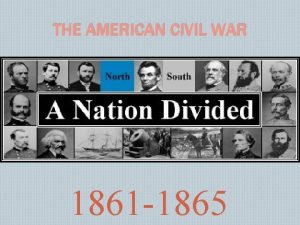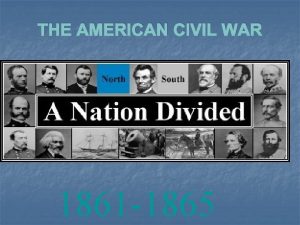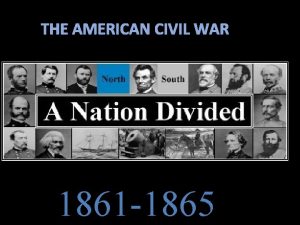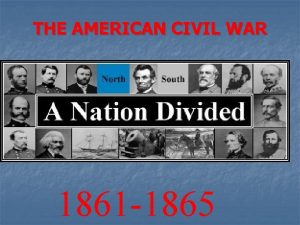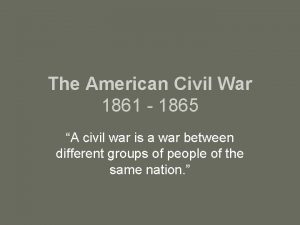Civil War 1 The Civil War 1861 1865























- Slides: 23

Civil War 1

The Civil War (1861 -1865) Standard 4. 3: Outline the course and outcome of the Civil War, including the role African American military units, impact of the Emancipation Proclamation; and the geographic, political, and economic factors involved in the defeat of the Confederacy. Original source: Susan M. Pojer

North vs. South in 1861 North South Advantages ? ? Disadvantages ? ?

Rating the North & the South

Slave/Free States Population, 1861

Railroad Lines, 1860

Resources: North & the South

The Union & Confederacy in 1861

Men Present for Duty in the Civil War

Overview of the North’s Civil War offensive Strategy: “Anaconda” Plan 1. Blockade Southern Ports 2. Split the South along the Mississippi River 3. Capture the Confederate capital at Richmond, VA Overview of the South’s Strategy: • Defend their land until the North tired out and quit

The “Anaconda” Plan

Lincoln’s Generals Winfield Scott Irwin Mc. Dowell George Mc. Clellan Joseph Hooker Ambrose Burnside Ulysses S. Grant George Meade George Mc. Clellan, Again!

The Confederate Generals “Stonewall” Jackson Known for bravery at Bull Run John B. Hood Known for his aggressive attacks James Longstreet “old warhorse” Nathan Bedford Forrest Known for ruthlessness at Ft. Pillow and a founding KKK Pierre Beauregard Known for leading forces in Charleston Robert E. Lee The head General of all Confederate forces

Battle of Bull Run (1 st Manassas) July, 1861 • First major battle between the 2 forces. • It was a see-saw battle between the two. • The Confederates were finally able to claim victory, but failed to continue on to capture the capital.


New Inventions

The Battle of the Ironclads, March, 1862 The Monitor vs. the Merrimac

War in the East: 18611862

Battle of Antietam “Bloodiest Single Day of the War” September 17, 1862 General Mc. Clellan was able to defeat the Confederate forces because someone found Lee’s plans around a pack of cigars!! 23, 000 casualties


The Emancipation Proclamation

The Emancipation Proclamation • It was promoted as a ‘military measure’ against the South. Yet, it was truly a political and diplomatic document. • By making a goal of the war to free the slaves, Lincoln was able to prevent Britain from supporting the South. • Lincoln announced that the Proclamation would not be put into effect until the 1 stof the year, thus giving the South a chance to make peace. • The Emancipation Proclamation did NOT immediately free the slaves nor did it free slaves in areas under Union control or border states. • It only freed states in rebellion!! • Since confederates were not going to listen to Lincoln, slaves were only freed as Union forces captured the are or if they fled to behind Union lines.

Emancipation in 1863
 Civil war 1861/1862
Civil war 1861/1862 Civil war 1861/1862
Civil war 1861/1862 Currie v misa
Currie v misa South carolina 1861
South carolina 1861 Indian councils act 1861
Indian councils act 1861 South carolina 1861
South carolina 1861 Unionistička stranka 1861
Unionistička stranka 1861 Springfield model 1861 rifle facts
Springfield model 1861 rifle facts Why was the civil war considered the first modern war
Why was the civil war considered the first modern war Chapter 16 lesson 2 challenges to slavery
Chapter 16 lesson 2 challenges to slavery Hollywood silver fox farm v emmett
Hollywood silver fox farm v emmett American literature 1865 to 1914
American literature 1865 to 1914 Becoming a world power 1865-1917
Becoming a world power 1865-1917 Al cruzar una planta de guisantes de flores purpura
Al cruzar una planta de guisantes de flores purpura The rise of industrial america 1865-1900
The rise of industrial america 1865-1900 Industrialization (1865 to 1901 worksheet answers key)
Industrialization (1865 to 1901 worksheet answers key) Traits of impressionism
Traits of impressionism Where did the term “impressionism” come from?
Where did the term “impressionism” come from? The rise of industrial america 1865-1900
The rise of industrial america 1865-1900 1865 to 1900 inventions
1865 to 1900 inventions Chapter 20 becoming a world power notes
Chapter 20 becoming a world power notes Urban america 1865 to 1896
Urban america 1865 to 1896 1877-1865
1877-1865 Industrialization (1865 to 1901 worksheet answers key)
Industrialization (1865 to 1901 worksheet answers key)
